Nosebleed treatment at home. Nosebleed Treatment: 4 Effective Home Remedies to Stop Bleeding Fast
How can you stop a nosebleed at home. What are the most effective techniques to control nasal bleeding. When should you seek medical care for a nosebleed. What are the best ways to prevent frequent nosebleeds from occurring.
Understanding Nosebleeds: Causes and Types
Nosebleeds, medically known as epistaxis, are a common occurrence that many people experience at some point in their lives. They happen when blood vessels in the nasal passages rupture and bleed. While often harmless, understanding the causes and types of nosebleeds can help you manage them more effectively.
What causes nosebleeds?
Nosebleeds can be triggered by various factors, including:
- Dry air
- Nose picking
- Trauma to the nose
- Allergies
- Sinus infections
- Blood-thinning medications
- High blood pressure
- Certain medical conditions
Types of nosebleeds
There are two main types of nosebleeds:
- Anterior nosebleeds: These occur in the front part of the nose and are the most common type. They’re usually easy to control at home.
- Posterior nosebleeds: These originate from the back of the nose and are more serious, often requiring medical attention.
4 Effective Home Remedies to Stop a Nosebleed
When faced with a nosebleed, it’s essential to know how to manage it effectively. Here are four proven steps to stop a nosebleed at home:

1. Sit upright and lean forward
Why is this position important? Sitting upright helps reduce blood pressure in the nasal veins, which can slow the bleeding. Leaning forward prevents blood from flowing down your throat, which can cause nausea and vomiting.
2. Pinch your nose
How should you pinch your nose to stop a nosebleed? Use your thumb and index finger to firmly pinch both nostrils shut, even if only one side is bleeding. Hold this position for 10-15 minutes without releasing. This applies pressure to the bleeding point and often stops the flow of blood.
3. Apply a cold compress
Why use a cold compress? Applying a cold compress or ice pack to the bridge of your nose can help constrict blood vessels and slow bleeding. Wrap the ice in a cloth to protect your skin from direct contact with the cold.
4. Use a nasal decongestant spray
How can a nasal spray help? After blowing your nose gently to remove any clots, you can use an over-the-counter nasal decongestant spray. These sprays can help constrict blood vessels and reduce bleeding.

When to Seek Medical Attention for a Nosebleed
While most nosebleeds can be managed at home, there are situations where medical intervention is necessary. It’s crucial to recognize these scenarios to ensure proper care.
Red flags for nosebleeds
Seek immediate medical attention if:
- The bleeding lasts longer than 30 minutes despite compression
- The nosebleed follows a head injury
- You’re experiencing an unusually heavy blood flow
- You’re having difficulty breathing
- The patient is a child under 2 years old
- You’re taking blood-thinning medications
Preventing Recurrent Nosebleeds: Practical Tips
If you’re prone to nosebleeds, taking preventive measures can significantly reduce their frequency. Here are some effective strategies to keep nosebleeds at bay:
Maintain nasal moisture
How can you keep your nasal passages moist? Use a humidifier in your home, especially during dry winter months. Apply a thin layer of petroleum jelly inside your nostrils using a cotton swab. Saline nasal sprays can also help moisturize the nasal membranes.

Avoid irritants
What substances can trigger nosebleeds? Limit exposure to smoke, chemical fumes, and other airborne irritants that can dry out and inflame nasal passages. If you have allergies, manage them properly to reduce nasal inflammation.
Practice gentle nose care
How should you care for your nose to prevent bleeding? Blow your nose gently, avoid picking your nose, and trim your fingernails (or your child’s) to discourage nose picking. When blowing your nose, do so gently and avoid excessive force.
Understanding the Link Between Nosebleeds and Medical Conditions
While most nosebleeds are benign, they can sometimes be a symptom of underlying health issues. It’s important to be aware of these potential connections.
Nosebleeds and high blood pressure
Is there a link between hypertension and nosebleeds? While high blood pressure doesn’t directly cause nosebleeds, it can make them more severe and harder to stop. If you have frequent or severe nosebleeds and high blood pressure, consult your doctor for proper management.

Nosebleeds and blood disorders
Can blood disorders cause frequent nosebleeds? Yes, certain blood disorders like hemophilia or von Willebrand disease can lead to easy bleeding, including frequent nosebleeds. If you experience unexplained or recurrent nosebleeds, it’s worth discussing with your healthcare provider.
Nosebleeds in Children: Special Considerations
Nosebleeds are common in children, but they can be particularly distressing for both the child and parents. Understanding how to manage and prevent nosebleeds in kids is crucial.
Why are children prone to nosebleeds?
Children often get nosebleeds due to several factors:
- Frequent colds and allergies
- Nose picking
- Dry air
- Injuries from falls or sports
Managing nosebleeds in children
How can you help a child with a nosebleed? The steps are similar to those for adults: have the child sit upright, lean slightly forward, and pinch the soft part of the nose for 10-15 minutes. Comfort and reassure the child throughout the process.
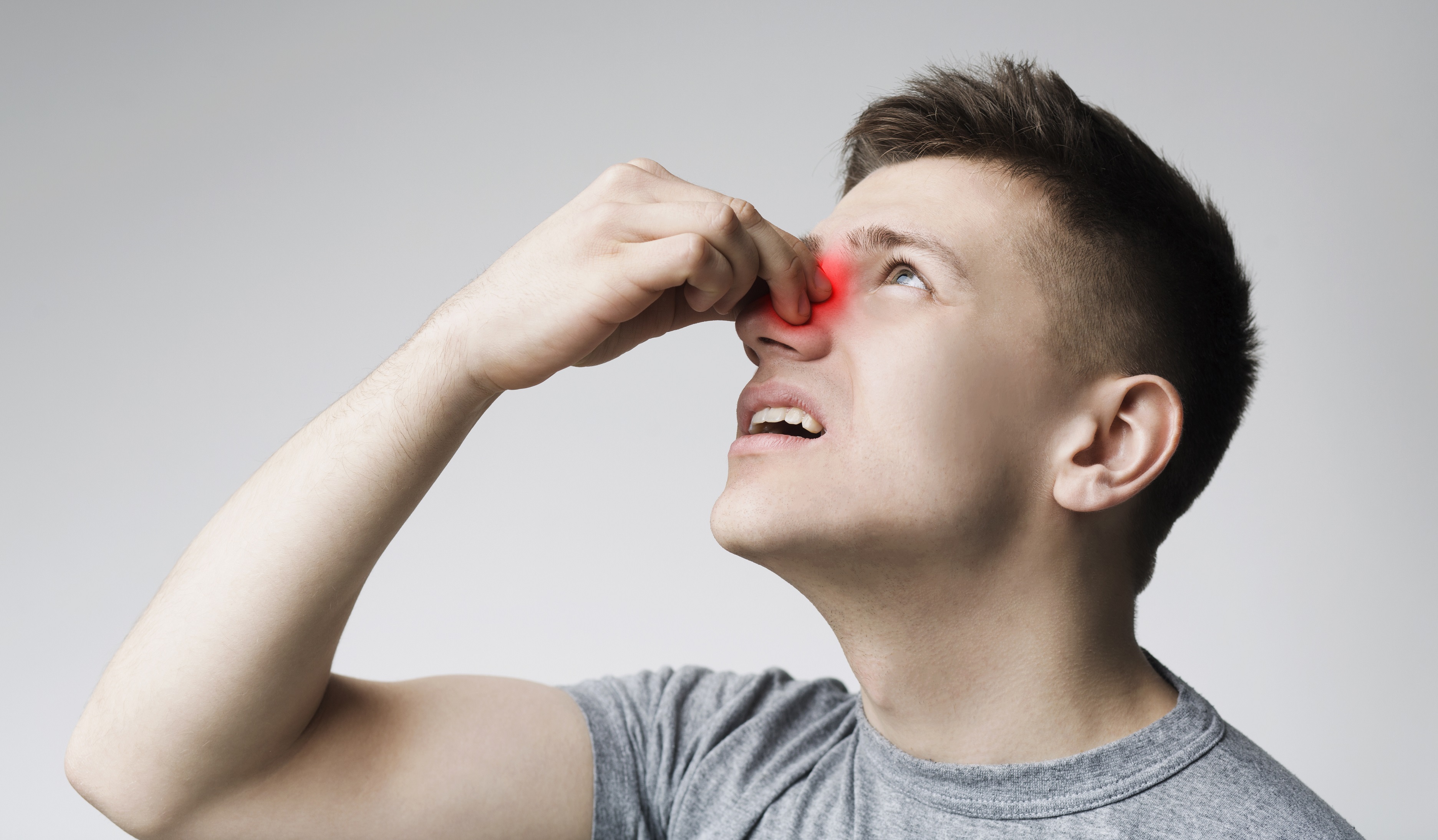
Preventing nosebleeds in kids
What can parents do to reduce the frequency of nosebleeds? Keep your child’s fingernails trimmed, use a humidifier in their room, and teach them not to pick their nose. If allergies are an issue, work with your pediatrician to manage them effectively.
The Impact of Climate and Environment on Nosebleeds
Environmental factors play a significant role in the occurrence of nosebleeds. Understanding these influences can help you take proactive measures to prevent them.
Dry climates and nosebleeds
Why do dry climates increase the risk of nosebleeds? Low humidity can dry out the nasal membranes, making them more susceptible to cracking and bleeding. If you live in a dry climate or during winter months when indoor heating dries the air, take extra precautions to keep your nasal passages moist.
Altitude and nosebleeds
Does high altitude increase the likelihood of nosebleeds? Yes, higher altitudes can lead to more frequent nosebleeds due to the drier air and lower oxygen levels. If you’re traveling to high-altitude locations, be prepared with nasal moisturizers and stay well-hydrated.

Air pollution and nasal health
How does air pollution affect nosebleeds? Pollutants can irritate and inflame the nasal passages, potentially leading to more frequent nosebleeds. In areas with high pollution levels, consider using air purifiers at home and limiting outdoor exposure on days with poor air quality.
Nosebleeds and Medications: What You Need to Know
Certain medications can increase the likelihood or severity of nosebleeds. Understanding these connections is crucial for managing your health effectively.
Blood thinners and nosebleeds
How do blood thinners affect nosebleeds? Medications like aspirin, warfarin, and newer anticoagulants can make nosebleeds more frequent and harder to stop. If you’re on these medications and experiencing frequent nosebleeds, consult your doctor about potential adjustments or additional precautions.
Nasal sprays and nosebleeds
Can overuse of nasal sprays cause nosebleeds? Yes, prolonged use of certain nasal sprays, especially decongestants, can dry out and irritate the nasal lining, leading to nosebleeds. Always follow the recommended usage instructions and consider alternating with saline sprays to maintain moisture.

Managing medications to reduce nosebleed risk
What steps can you take if your medications are causing nosebleeds? Work closely with your healthcare provider to find the right balance. They may adjust dosages, switch medications, or recommend additional measures to protect your nasal health while managing your underlying condition.
Understanding the various aspects of nosebleeds, from their causes to effective management strategies, empowers you to handle these common occurrences with confidence. By implementing preventive measures and knowing when to seek medical attention, you can minimize the impact of nosebleeds on your daily life. Remember, while most nosebleeds are harmless, persistent or severe cases warrant professional evaluation to ensure there are no underlying health concerns.
Home Remedies: 4 steps to stop a nosebleed
By
Dana Sparks
Most nosebleeds aren’t serious and will stop on their own or by following self-care steps.
Seek emergency medical care if nosebleeds:
- Follow an injury, such as a car accident
- Involve a greater than expected amount of blood
- Interfere with breathing
- Last longer than 30 minutes even with compression
- Occur in children younger than age 2
Don’t drive yourself to an emergency room if you’re losing a lot of blood. Call 911 or your local emergency number or have someone drive you.
Talk to your health care provider if you’re having frequent nosebleeds, even if you can stop them fairly easily. It’s important to determine the cause of frequent nosebleeds.
Self-care steps for occasional nosebleeds include:
- Sit upright and lean forward.

By remaining upright, you reduce blood pressure in the veins of your nose. This discourages further bleeding. Sitting forward will help you avoid swallowing blood, which can irritate your stomach. - Gently blow your nose to clear out any clotted blood. Spray a nasal decongestant in the nose.
- Pinch your nose.
Use your thumb and index finger to pinch both nostrils shut, even if only one side is bleeding. Breathe through your mouth. Continue to pinch for five to 10 minutes. This maneuver puts pressure on the bleeding point on the nasal septum and often stops the flow of blood. - Repeat.
If the bleeding doesn’t stop, repeat these steps for up to a total of 15 minutes.
After the bleeding has stopped, to keep it from starting again, don’t pick or blow your nose and don’t bend down for several hours. Keep your head higher than the level of your heart.
Tips to help prevent nosebleeds include:
- Keeping the lining of the nose moist.

Especially during colder months when air is dry, apply a thin, light coating of petroleum jelly (Vaseline) or antibiotic ointment (bacitracin, Neosporin) with a cotton swab three times a day. Saline nasal spray also can help moisten dry nasal membranes. - Trimming your child’s fingernails.
Keeping fingernails short helps discourage nose picking. - Using a humidifier.
A humidifier will counteract the effects of dry air by adding moisture to the air.
This article is written by Mayo Clinic staff. Find more health and medical information on mayoclinic.org.
Related articles
Mayo Clinic Minute: How heat affects medication
Finding ways to keep your body cool during extremely high temperatures is important, and so is ensuring your medications aren’t exposed to extreme heat.
Scott Hall, a Mayo …
By Deb Balzer • July 14, 2023
Understanding effects of heat on mental health
A heat wave is affecting parts of the U.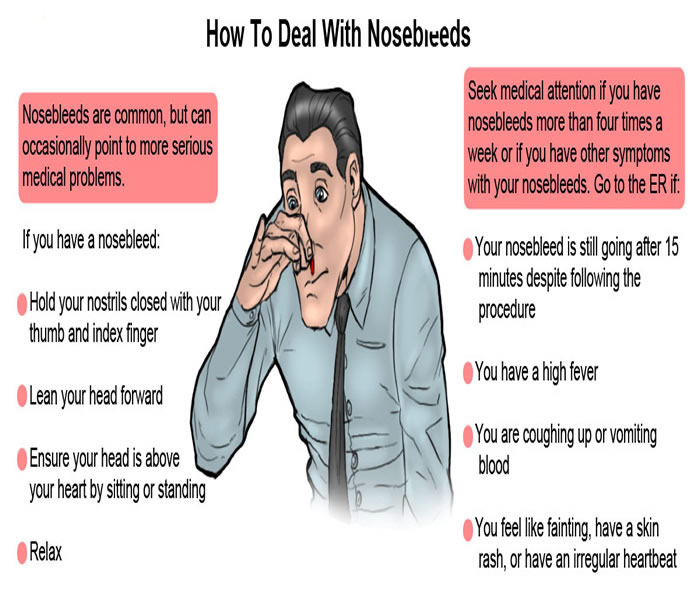 S., including much of the Southwest, through the Southeast and parts of Europe. When temperatures soar, the …
S., including much of the Southwest, through the Southeast and parts of Europe. When temperatures soar, the …
By Deb Balzer • July 13, 2023
Mayo Clinic Minute: Heat exhaustion and heatstroke
Extreme heat continues to cause issues across the country and the globe. Excessive heat warnings are out in many areas, including the Phoenix area where …
By Jason Howland • July 12, 2023
Causes, treatment, and home remedies
Nosebleeds are common because of the position of the nose and its high density of blood vessels. Most are not serious, but sometimes a nosebleed can indicate a more severe underlying condition, such as leukemia.
Local trauma is the most common cause of nosebleeds. This can range from blows to the face to nose picking. However, foreign bodies, nasal or sinus infections, and prolonged inhalation of dry air can also cause them.
Nosebleeds, known medically as epistaxis, are typically not a cause for concern. In rare cases, however, they can be life threatening.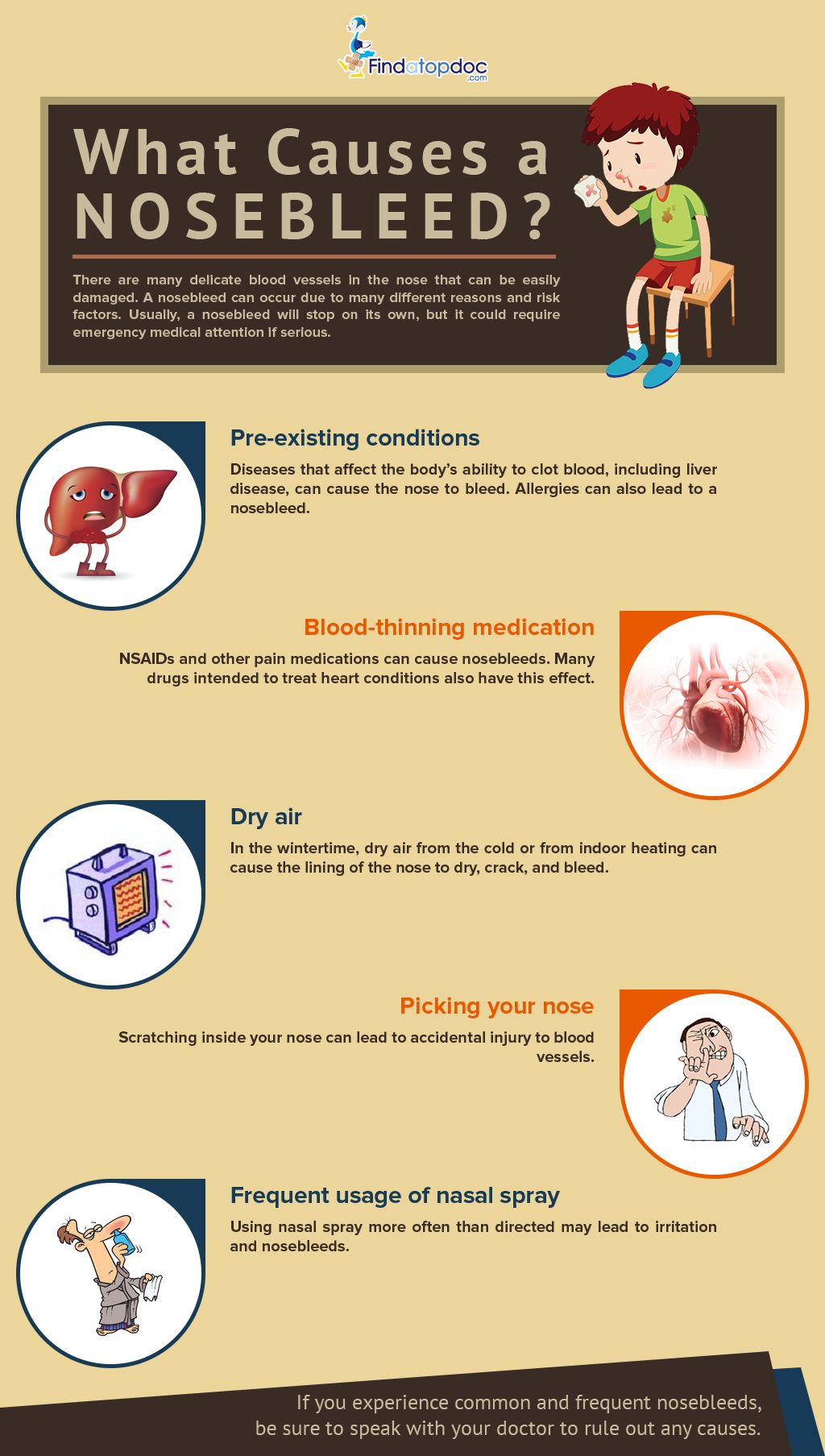
In this article, we detail what nosebleeds are, what causes them, and how a person can treat and prevent them from occurring.
A nosebleed is blood loss from the tissue inside a person’s nose. This is a common occurrence and rarely a cause for concern. The medical term for a nosebleed is epistaxis.
The nose is full of blood vessels, which is why even minor injuries to the face can cause the nose to bleed. Nosebleeds may also occur without outside influence. These may appear spontaneously but often result from unseen factors.
For example, when the mucous membrane — which is a mucus-secreting tissue inside the nose — dries, crusts, or cracks, it will cause bleeding.
Nosebleeds are also common in people taking anticoagulants, as well as those with bleeding disorders. Anticoagulants are blood-thinning medications, such as aspirin.
Share on PinterestNose bleeds are caused by rupture of blood vessels in the nasal mucosa. Credit: Wenzdai Figueroa.
Nosebleeds can be either anterior or posterior.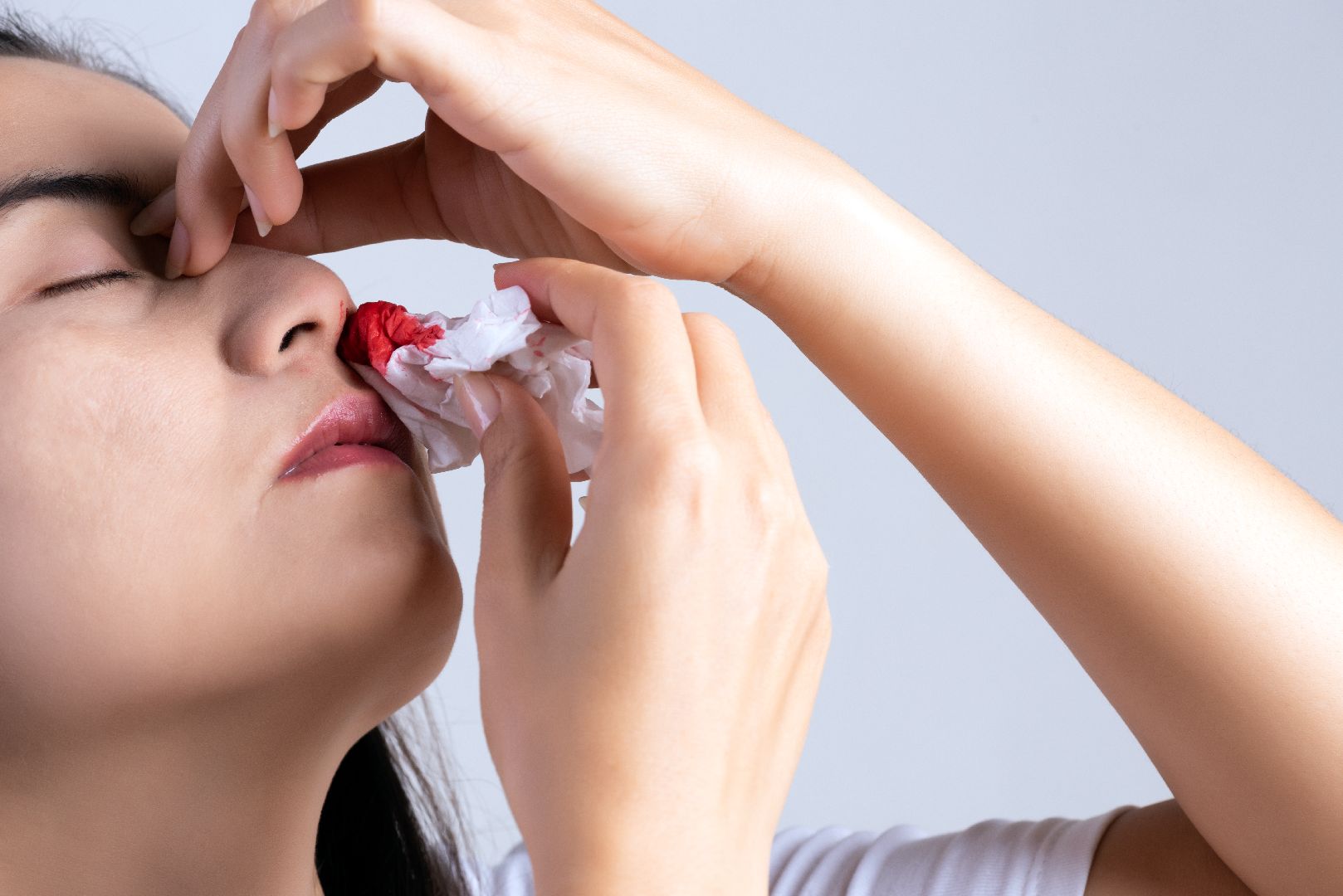
In anterior nosebleeds, the bleeding comes from the wall between the two nostrils. This part of the nose contains many delicate blood vessels. Anterior nosebleeds are the most common type of nosebleed.
In posterior nosebleeds, the bleeding originates farther back and higher up the nose. This area of the nasal cavity contains artery branches that supply blood to the nose. Ruptures to these arteries cause heavy bleeding that may alternate with periods of no bleeding at all.
Posterior nosebleeds are often more serious than anterior ones and may require medical attention.
Common causes of nosebleeds
Common causes of nosebleeds include:
- Direct injury: A blow to the face may damage the lining of a person’s nose, which can cause bleeding.
- Irritation: Frequent picking or blowing of the nose can make its lining more likely to bleed.
- Foreign bodies: Foreign bodies in the nasal cavity can disturb local tissue and blood vessels.

- Air travel and altitude: Changes in altitude and air pressure can cause nasal blood vessels to expand and contract. These disturbances can lead to nosebleeds.
- Inflammation: Inflammation due to allergies or infections, such as sinusitis, can damage blood vessels in the nose.
- Humidity: Climates with low humidity can cause cracking in nasal tissue. This in turn can lead to bleeding.
- Liver disease: Liver disease can interfere with blood clotting and result in frequent or severe nosebleeds.
- Medications: The use of blood thinners or nonsteroidal anti-inflammatory drugs can cause nosebleeds. Nasal steroid medications can also dry the nasal lining, increasing the risk of a nosebleed.
- Illegal drugs: The use of cocaine or other nasally ingested drugs can disturb the nasal lining and cause bleeding.
- Irritants: Exposure to smoke or irritant fumes can damage the nasal lining and cause nosebleeds.

- Radiation therapy and chemotherapy: Chemotherapy can lower the number of platelets in the blood. This makes blood clotting more difficult, and bleeding more common.
Other causes of nosebleeds
In some cases, underlying health conditions and less common occurrences can result in nosebleeds. These include:
- conditions affecting blood vessels, such as hereditary hemorrhagic telangiectasia
- nasal surgery
- calcium deficiency
- blood diseases, such as hemophilia and leukemia
- some tumors
The main symptom of a nosebleed is blood coming from the nose. This bleeding can vary in severity and can come out of one or both nostrils. Posterior nosebleeds are more likely to cause bleeding in both nostrils.
If the nosebleed occurs while a person is lying down, they will typically feel liquid in the back of the throat before the blood comes from the nose.
Most nosebleeds are not a medical emergency, and people can treat them at home. The first step of home treatment is to stop the bleeding.
The first step of home treatment is to stop the bleeding.
A person should do the following:
- Sit down and pinch the soft parts of the nose firmly, breathing through the mouth.
- Lean forward to prevent blood from draining into the sinuses and throat, which can result in inhaling the blood or gagging.
- Sit upright so that the head is higher than the heart. This reduces blood pressure and slows further bleeding.
- Continue putting pressure on the nose, leaning forward, and sitting upright for 10–15 minutes so that the blood clots. If bleeding persists for more than 20 minutes, medical attention is necessary.
Individuals should seek medical attention immediately if:
- they experience frequent nosebleeds
- they have sustained an injury to the head
- they are taking blood-thinning medications
- the bleeding lasts more than 10–15 minutes
- they experience heart palpitations
A doctor will attempt to stop the bleeding as the first course of action.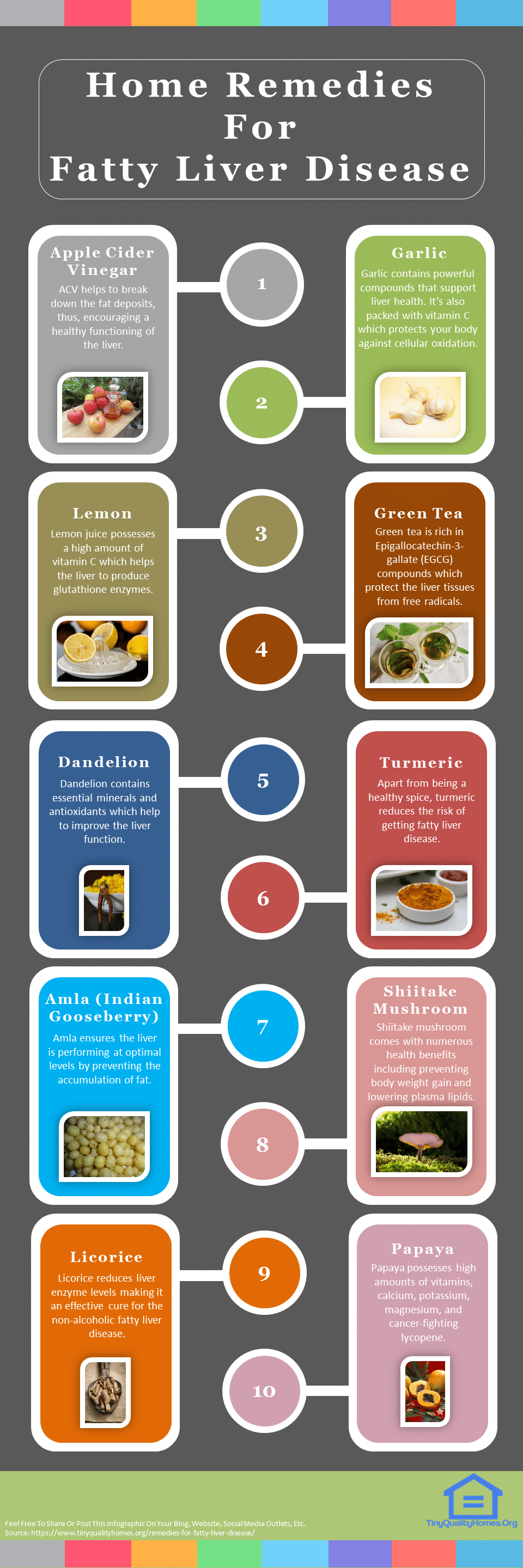 They may also check a person’s blood pressure and pulse.
They may also check a person’s blood pressure and pulse.
If they suspect a fracture in the nose or face, they may also order an X-ray before recommending a suitable treatment option.
The severity of a person’s nosebleed, as well as its underlying cause, will direct treatment. Common treatment options include:
- Nasal packing: A doctor may insert ribbon gauze or special nasal sponges into the nasal cavity to put pressure on the source of the bleed.
- Cautery: In this procedure, a medical professional cauterizes, or burns, an area of nasal lining to seal bleeding blood vessels.
- Embolization: In embolization, a surgeon will insert materials into blood vessels or arteries to block blood flow. This will stop any bleeding from the nose. However, doctors will rarely recommend this for nosebleeds.
- Septal surgery: If a deviated septum is causing frequent nosebleeds, a doctor may straighten it during a surgery.

- Ligation: This surgical procedure involves tying the ends of the identified blood vessels or arteries causing the bleeding. Medical professionals typically use nasal ligation if other treatment options have not worked. Only 5–10% of posterior nosebleed cases require ligation.
There are several things a person can do to prevent the onset of nosebleeds, such as:
- avoiding picking the nose
- avoiding blowing the nose too hard or too frequently
- avoiding exertion or strenuous activity after nosebleeds
- avoiding irritants and drying nasal medications
- having the mouth open when sneezing
Keeping the lining of the nose moist can help prevent nosebleeds. For example, using nasal saline sprays and humidifiers at high altitudes or in dry climates may be of benefit to some people.
One 2018 review found a correlation between humidity and a reduction in nosebleed incidence in children. However, other reviews in pediatric settings found only insignificant links between the two.
Nosebleeds are a common occurrence that typically do not require emergency medical attention. They are often the result of direct injury or irritation, and a person can treat them at home with rest and nasal packing.
However, in some cases, nosebleeds occur due to underlying conditions. If a person experiences severe or recurrent bleeding that does not stop, they should contact a doctor.
People taking blood thinners or living with conditions that impair blood clotting should seek immediate emergency care if they experience a nosebleed. Surgical interventions include cautery, embolization, and ligation.
Minimizing irritation to the nasal lining, avoiding activities that may result in facial injury, and keeping the inside of the nose moist can all help prevent nosebleeds.
Read this article in Spanish.
Stopping nosebleeds: professional treatment in Odessa
Causes
Like any other blood loss, nosebleeds are dangerous to human health.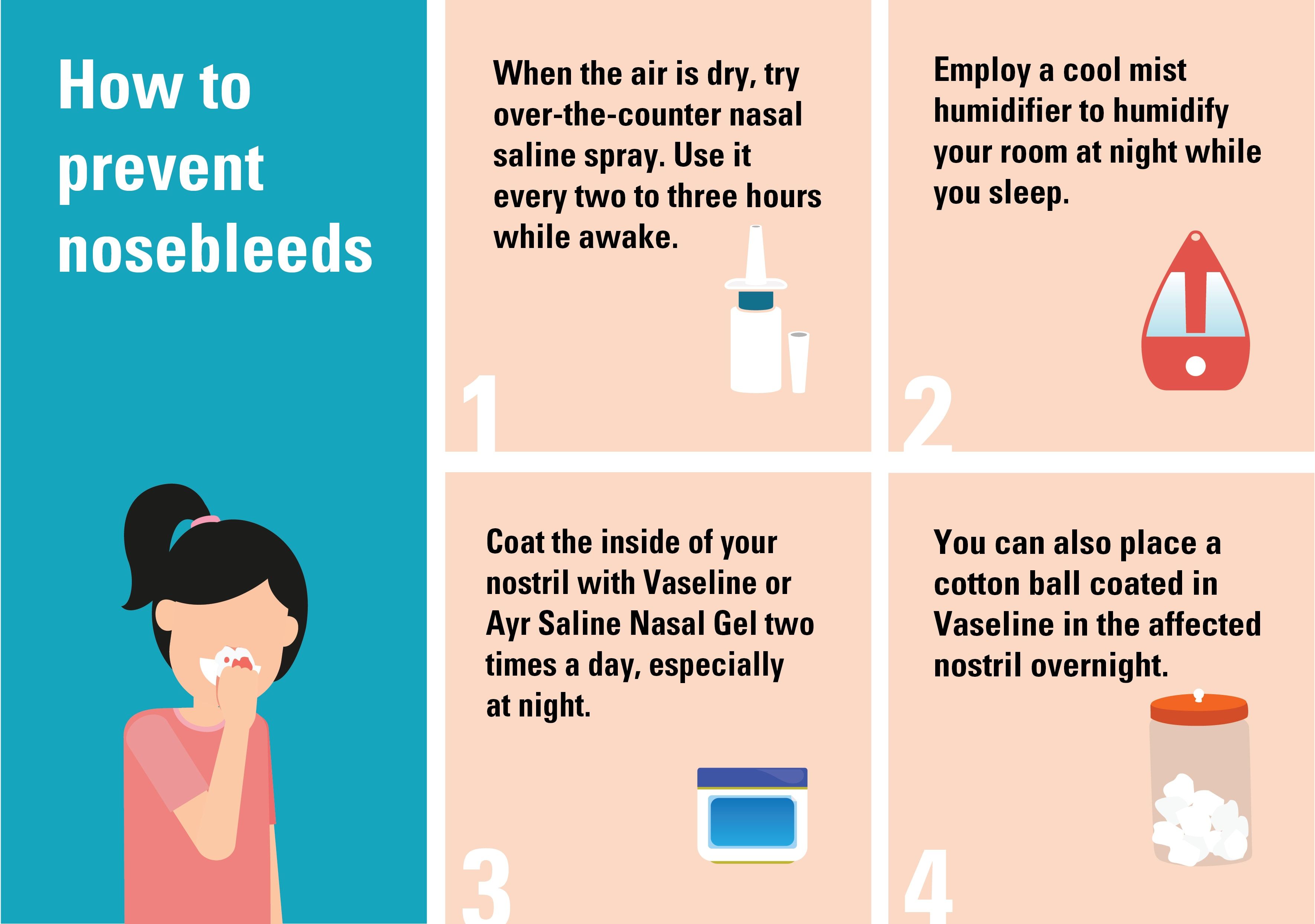 According to statistics, approximately one in ten patients in the ENT departments are hospitalized due to nosebleeds.
According to statistics, approximately one in ten patients in the ENT departments are hospitalized due to nosebleeds.
ENT specialists divide the causes of nosebleeds into two groups:
- local – when the problem concerns only the nose. These are bleeding that appeared due to injuries, foreign bodies entering the nasal cavity. This also includes the consequences of diseases that cause blood flow to the mucous membrane – for example, chronic rhinitis, otitis, adenoiditis. The source of hemorrhage is changes in the nasal cavity – dystrophic processes of the mucosa, significant curvature or neoplasms of the septum – both benign and malignant;
- general . All parts of our body depend on each other, and the source of the ailment is far from the sphere of activity of the doctor “ear throat nose”. Thus, SOS signals are given by various cardiovascular diseases – hypertension, atherosclerosis, heart disease, vascular anomalies, in which pressure increases; hemorrhagic diathesis, beriberi; heat and sunstroke, overheating, fever; diseases in acute stages; sudden pressure drops.
 Moreover, the causes may be hidden in pregnancy or puberty.
Moreover, the causes may be hidden in pregnancy or puberty.
It is important to realize that any, even the smallest bleeding from the nose, is already a signal to visit an otolaryngologist, because by itself a person, without a medical education, cannot find the cause.
Symptoms
Bleeding from the nose or bleeding from the nasopharynx are the main symptoms of this condition. With massive nosebleeds, pronounced signs of blood loss appear:
- weakness;
- ringing and noise in the ears;
- dizziness;
- thirst;
- palpitations;
- pale skin and mucous membranes.
Bleeding in the “front” parts of the nose – usually not intense, the patient can stop it himself or consult a doctor.
Larger blood vessels are concentrated in the deeper parts of the nose. Such bleeding is more dangerous and requires urgent medical attention and the use of special methods.
First Aid for Nosebleeds
Stopping the bleeding is best left to a qualified, experienced otolaryngologist. The ENT doctor will determine the cause and nature of the situation, provide assistance and prescribe further treatment and examination, if necessary.
The ENT doctor will determine the cause and nature of the situation, provide assistance and prescribe further treatment and examination, if necessary.
There are a number of simple steps that can be taken before a visit to the clinic to remove external manifestations, try to stop the bleeding and stabilize the person’s condition as much as possible. Self-administer first aid should only be for minor bleeding.
The victim should be seated, his head slightly tilted forward and a cotton swab soaked in hydrogen peroxide placed in the common nasal passage. A cold object applied to the bridge of the nose, for example, a bandage with ice, will help to improve the situation.
Contrary to popular popular advice, do not tilt your head back or lay a person in a prone position – in this case, bleeding may increase.
It should be noted that all these manipulations will not solve the problem, but only eliminate its external symptoms. Only an ENT during the examination will be able to determine the real cause and prescribe a competent complex treatment for a high-quality and long-term result.
Video on the topic
Methods for stopping nosebleeds
For diagnosis, the doctor takes an anamnesis, examines the patient, and stops nosebleeds. If necessary, he prescribes medication and additional examination.
It is impossible to single out one universal method applicable to all situations. The ENT will be able to choose the best way only, based on the results of the initial examination, the nature and causes of bleeding, its massiveness and side symptoms.
Based on this, the otolaryngologist chooses a certain method of stopping the blood:
- if the problem is due to damage to the vessels in the anterior parts of the nose, the doctor uses the method of anterior tamponade. A long tampon is inserted into the nasal cavity and placed in a special way – with an accordion. Do not try to carry out this manipulation at home: an incorrectly inserted tampon will exacerbate the problem.
 This method is performed on an outpatient basis.
This method is performed on an outpatient basis.
In the LORIC clinic in Odessa, a modern method of tamponade is performed: painless and safer than traditional manipulation. A special tape or sponge is impregnated with an antibacterial ointment or gel to avoid the inflammatory process, and injected into the nasal cavity. After the bleeding stops, the patient can return home.
- in severe massive bleeding in the posterior sections, otolaryngologists resort to the method of posterior tamponade. The large diameter of the posterior vessels contributes to the occurrence of profuse blood loss. They almost never can stop on their own – only after qualified medical care. Posterior tamponade is a complex procedure that is performed only in a hospital setting.
Quite often people come to LORICA with recurrent bleeding – when, due to regular damage, erosions appear on the mucosa, which bleed from time to time.
To eliminate this kind of problem, another method is used – cauterization. Such therapy requires considerable experience and skill of an otolaryngologist and helps to effectively get rid of the problem in just one session. First, the doctor treats the bleeding site with an anesthetic to avoid discomfort during the procedure, and then cauterizes. As a rule, after that a specific problem is solved once and for all.
Such therapy requires considerable experience and skill of an otolaryngologist and helps to effectively get rid of the problem in just one session. First, the doctor treats the bleeding site with an anesthetic to avoid discomfort during the procedure, and then cauterizes. As a rule, after that a specific problem is solved once and for all.
All of the above methods to stop the bleeding are accompanied by drug therapy in order not only to remove the external signs, but also to solve the essence of the problem.
Related video
Complications
Nosebleeds – an unpleasant and dangerous condition . With independent attempts to stop massive bleeding, in case of untimely access to the doctor and, as a result, a large loss of blood, serious problems can arise.
Do not risk your life even at the first symptoms – entrust the care of it to professionals, practicing ENT specialists of the LORICA clinic.
Cost of services
Stopping nosebleeds by cauterization
UAH 350
Stopping nosebleeds | Dobromed
Bleeding is an unpleasant thing, especially if it starts out of nowhere. So that it does not overtake you by surprise, study this information and remember the procedure for stopping nosebleeds. Due to the large accumulation of blood vessels in a person’s nose, sometimes even a minor blow or injury causes bleeding. How to stop nosebleeds? In some cases, it is better to immediately seek help from doctors, but in other situations, this problem is successfully solved at home. How to do this, read on.
How to deal with a nosebleed
The first step is to determine how serious the situation is. Pay attention, after which the bleeding occurred and how intense it is. It happens that the blood drips a little and stops by itself. Small bleeding can also be stopped on its own. If the bleeding is strong and accompanied by other signs (serious damage to the skin, fainting, darkening in the eyes, hysteria or increased pressure) or bleeding is complicated by chronic diseases of the blood, cardiovascular system, you must urgently call an ambulance and follow the instructions of the telephone operator before arrival doctor.
Causes of nosebleeds
Look at this list. Each of the items can cause nosebleeds.
- body overheating;
- beriberi;
- decreased blood clotting;
- weak vessels;
- trauma to the nose;
- inflammatory processes in the nasal passage;
- high blood pressure;
- pathologies of the cardiovascular system;
- existing serious illnesses, such as: leukemia or anemia;
- decreased production of platelets in the body;
- taking medications;
- the presence of a neoplasm in the nasal passage.
What can precede nosebleeds
Occasionally, before the onset of nosebleeds, headaches, discomfort in the nasal cavity, dizziness or tinnitus occur. The presence of at least one of these signs may indicate an imminent onset of bleeding. This situation can happen to anyone, but this situation causes the most questions when it occurs in a small child, during pregnancy or at high pressure.
How to properly stop a nosebleed in young children
- to begin with, the child must be seated so that the blood can flow freely;
- Ice should be placed on the bridge of the nose, neck or forehead. If it is not there, you can take any cold product from the refrigerator. Feet at this time should be warm;
- Press the wing of the bleeding nostril against the septum for 15 seconds. During this time, the bleeding should stop;
- if the bleeding is strong, place a swab in the nostril that is moistened with a small amount of hydrogen peroxide (simply salt water will do), or use vasoconstrictor drops.
To prevent this condition, it is important for the child to be outdoors more often (in any weather). Healthy helps to strengthen vessels swimming and hardening. Periodically humidify the air in the room where the child spends most of the time. It is important that his diet is varied and contains all the necessary trace elements and vitamins. In young children, nosebleeds often cause frequent nose picking. Make sure your child doesn’t do this. If physical activity is the cause of the problem, it is necessary to review the baby’s daily routine and reduce them.
In young children, nosebleeds often cause frequent nose picking. Make sure your child doesn’t do this. If physical activity is the cause of the problem, it is necessary to review the baby’s daily routine and reduce them.
How to stop nosebleeds during pregnancy
Sit down so that it flows freely from the nasal cavity. Then follow the instructions below. First of all, close both nostrils for 15-20 seconds. If that doesn’t work, try sticking a wet swab soaked in salt water or hydrogen peroxide into your nose. Ice on the bridge of your nose helps. You can press on the upper lip and hold your finger for 20 seconds. During this time, the bleeding should stop. Otherwise, it is recommended to call a doctor.
How to stop a nosebleed with high blood pressure
As mentioned above, sometimes nosebleeds appear against the background of high blood pressure. In order to stop the flow of blood from the nose with hypertension or a sudden increase in pressure, you first need to sit down or lie down (the head should be raised). Next, insert a cotton turunda into your nose, dipping it first in hydrogen peroxide or salt water, and sit or lie down quietly for 5-10 minutes. If the problem cannot be fixed, call an ambulance.
Next, insert a cotton turunda into your nose, dipping it first in hydrogen peroxide or salt water, and sit or lie down quietly for 5-10 minutes. If the problem cannot be fixed, call an ambulance.
Things that can make things worse
When trying to stop a nosebleed, several things can make things worse.
- Do not allow blood to enter the respiratory tract. To do this, lying on the bed, raise the headboard with a high pillow. It is also not recommended to tilt your head back. Blood must be spit out.
- When lying down, raising the legs leads to the redirection of blood towards the head, and this can provoke new bleeding from the nose. Avoid this position when bleeding stops.
- Great anxiety and drinking tea or coffee raises blood pressure. Try to calm down and do not drink these drinks to avoid increasing the intensity of blood flow.
- When the blood stops, a crust forms in the nose, which, like a cork, stops the bleeding. If you try to blow your nose right after that, you may bleed again.
 So, do not rush to blow your nose.
So, do not rush to blow your nose.
When to see a doctor
- when trying to stop a nosebleed, you feel a wound or some kind of damage in the nasal cavity;
- bleeding lasts more than 15 minutes and you cannot stop it;
- you have frequent nosebleeds (repeatedly within a week, for no apparent reason).
Natural remedies for stopping nosebleeds
The standard recommendations have been listed above, but you can also turn to effective traditional medicine. Try putting freshly squeezed lemon juice in your nose, a few drops in each nostril. You can dip a cotton swab in lemon juice and stick it in your nose for a few minutes. Change it if necessary. If you have nettle on hand (for example, you are in nature), squeeze the juice out of it and insert a cotton swab moistened with this juice into your nose. Some people successfully stop nosebleeds using the su-jok system. To do this, you need to bandage your thumb approximately at the level of the middle of the nail (use a bank gum or twine for this) and hold out for 10 minutes. According to the su-jok method, in this place there is a reflex zone corresponding to the nose area.
According to the su-jok method, in this place there is a reflex zone corresponding to the nose area.
Preventive measures
Dry air can also cause nosebleeds. For example, when heating is turned on, the air in apartments and offices becomes much drier than at other times. A well-chosen humidifier, placing wet towels on batteries, spraying the room with a spray bottle, frequent airing or indoor plants will help improve the situation. When the nasal mucosa dries out, crusts can form on it. To avoid this phenomenon, try periodically instilling it with 2-3 drops of rosehip oil or sea buckthorn oil. If bleeding in your case is associated with increased vascular fragility, consult your doctor. Rutin and ascorbic acid strengthen the vessels well. With reduced blood clotting, it is recommended to drink tea from herbs (yarrow, plantain, nettle, highlander, sea buckthorn fruits and leaves). A 5–10% solution of calcium chloride helps to reduce the permeability of the walls of blood vessels.



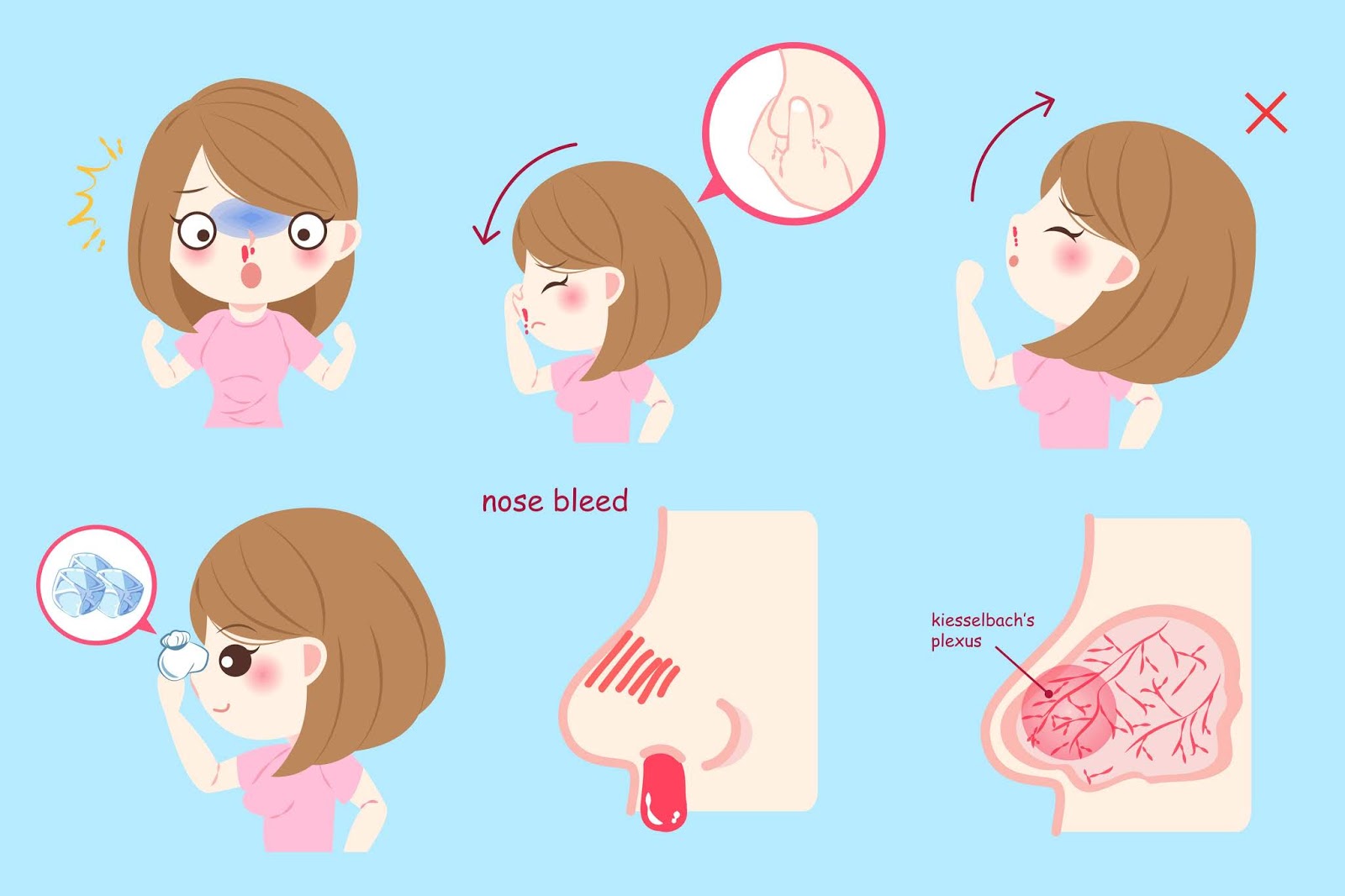
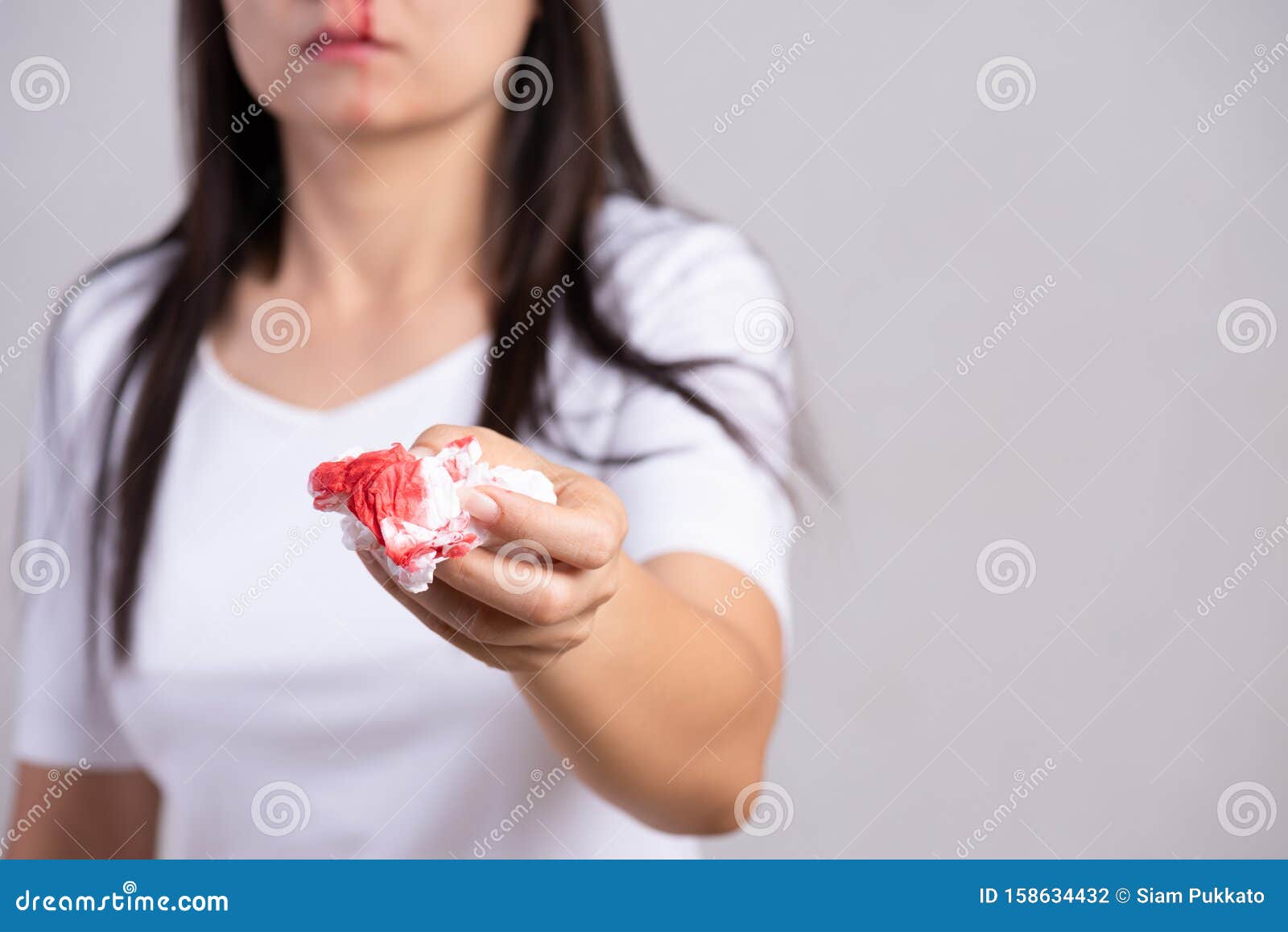
 Moreover, the causes may be hidden in pregnancy or puberty.
Moreover, the causes may be hidden in pregnancy or puberty. This method is performed on an outpatient basis.
This method is performed on an outpatient basis. So, do not rush to blow your nose.
So, do not rush to blow your nose.